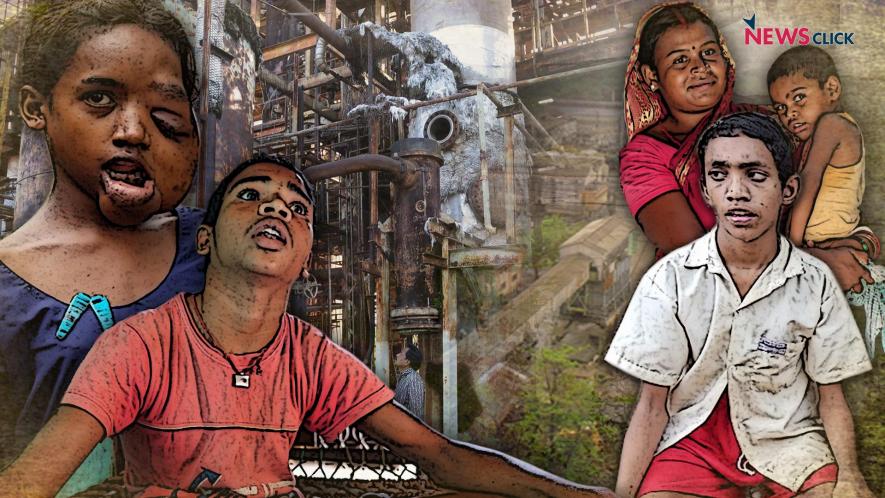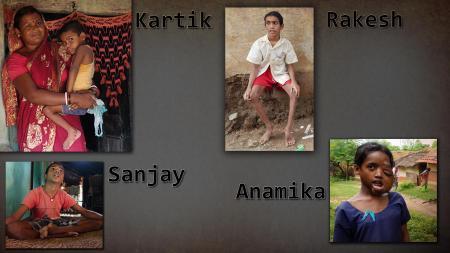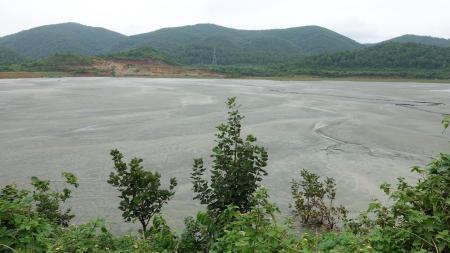Uranium Mining in Jharkhand: Radioactive Poisoning Ravaging Lives in Villages

Sanjay Gope, a 13-year-old boy from Bango village near Jadugora town in East Singhbhum district of Jharkhand, can not move or speak because he has been suffering from muscular dystrophy – a group of disorders that involves a progressive loss of muscle mass and consequent loss of strength – for the past nine years.
At least one person of his family has to be with him all the time to look after him. He cannot be left unattended.
Eighteen-year-old Parvati Gope from the same village is suffering from lumbar scoliosis – a C-shpaed curve formation of her vertebral column.
Rakesh Gope, a 13-year-old school-going boy, is also suffering from muscular dystrophy. Although he is active and walks with arched feet and soles, he is unable to speak normally.
A three-year-old child Kartik Gope has been having seizures since birth and is developing muscular dystrophy too.
These examples are not enough; there are hundreds of such cases of congenital illness and other birth defects in addition to high incidence of infertility, miscarriages and pre-mature deliveries.

Now, a pertinent question arises here: why are such large number of health hazards being reported from this remote and overlooked corner of the country?
While India is dreaming to become energy efficient by 2032 by generating 63 Gigawatts of nuclear power, it is taking a major toll on human lives in a small township of Jharkhand.
Jadugora has the deposits of world’s best quality uranium ore, magnesium diuranate. It is because of the rich deposits of the region, India is capitalising its nuclear dreams. The whole belt of the reactors is affecting the Adivasis (indigenous people) disproportionately in and around the uranium mining operational area.
“The tribals of Jadugora are being exposed to radioactivity directly and indirectly. Miners working in the mine areas inhale the dust and radon gas. Besides, the uranium ore are transported in uncovered trucks through roads that are full of bumps. This cause the debris to fall off on the sides of the road. Radiation are also caused by dumping of mine’s tailings in uncovered ponds,” said Ankush Vengurlekar, a photojournalist who has documented people’s suffering because of the “unsafe” mining.
Locals say villages lying close to the tailing ponds are the worst affected. During the dry season, dust from the tailings blows through these villages. During the monsoon rains, radioactive waste spills into the surrounding creeks and rivers, causing further internal radiation as villagers use the contaminated water for washing and drinking and also use the nearby ponds for fishing.

“Children living near the mines are born with swollen heads, blood disorders and skeletal distortions. Cancer as a cause of death is more common in villages surrounding uranium operations,” said a local from Jadugora.
According to a study by Indian Doctors for Peace and Development (IDPD), 68.33 per cent people are dying before the age of 62. The local river Subarnarekha that is flowing across the place is highly contaminated with uranium. The people living here are suffering from tortuous health problems.
Nuclear waste that is found in tons in the ponds of Jadugora is reportedly contaminating the entire place and is now creeping through soil into vegetation.
Professor Dipak Ghosh, a physicist and dean of the Faculty of Science at Jadavpur University in Kolkata, had collected samples from the river and also from adjacent wells a few years ago for research, and the result was alarming.
The water was contaminated with radioactive alpha particles that cannot be absorbed through the skin or clothes, but if ingested, cause 1,000 times more damage than other types of radiation. In some places, the levels were 160 percent higher than the safe limits set by the World Health Organisation.
Another study conducted by Dr. Hiroaki Koide of the Research Reactor Institute, Kyoto University, Japan, uncovered hard evidence of the toxic footprint cast by the country’s nuclear mining and fuel fabrication program.
He said the contamination from a uranium mine has spread in Jadugora.
“The gamma dose in the air exceeds 1 mSv/y in the villages and reaches 10mSv/y around the tailing ponds. The circumference of tailing ponds is polluted with uranium. The strength of the pollution is of 10 to 100 times is high in comparison with the place without contamination. Tailing pond has contamination of Cesium. This fact shows that radioactivity was brought from another polluted source which was not uranium mine. Especially Dungridih that is in contact with the tailing pond has high contamination. There is a shade of uranium contamination also in a same village, as high contamination has been measured at Tilaitand or other village. This cause is because tailings were used for the building materials. There are places where uranium concentration is high in the road or the riverside, and it is thought that tailings are used for construction material. At the Rakha Mine station, the soil is polluted by only uranium. Its concentration is remarkably high. This shows that the uranium obtained by smelting fell and extended contamination. Not only K-40 or thorium but uranium concentration is high in Ranchi,” suggest his findings.
The government’s and the company’s denial
A comprehensive new energy plan approved by the government in October 2015 declared that nuclear power is “safe, environmentally benign and economically viable source to meet the increasing electricity needs of the country”.
Uranium Corporation of India Limited (UCIL), the state-owned miner, too has denied all claims that the mining is affecting the small town and the communities living around it the uranium mines. Founded in 1967, the UCIL is a Public Sector Undertaking (PSU) under the Department of Atomic Energy for uranium mining and processing. The centrally owned miner is responsible for the mining and milling of uranium ore in India.
Standing beside the then United States President Barack Obama at a Paris conference on global warming on November 30, 2015, Prime Minister Narendra Modi had said, “...India is a very nature-loving country and we are setting out, as always, to protect nature in the world while producing energy.” There is hardly any safety standard the company is abiding by to handle radioactive materials.
Deprived of land first, and now health
The tribals of Jadugora were first deprived of their land, and now their health is being destroyed by making them labourers of a huge government enterprise. Moreover, they are subjected to the exposure to radioactivity in their everyday life.
Anti-radiation movement activist Arjun Samat opened Pandora’s box when asked about the labourers working in the mines and their issues. The UCIL employs contractual labourers to mine the highly sensitive ore of uranium and they are not provided any safety gear reportedly.
Mining is done by the contractual labourers at the remuneration of Rs 300 per day. They are not given any medical or health benefits, no protective suits or safety gear. Many lives have been lost so far in accidents but ironically, the affected were not given any compensation,” he told Newsclick.
“We had several rounds of talks with the company officials to try and pursue them for conducting medical tests for the contractual staff. The UCIL finally agreed to make medical tests compulsory for all daily wage workers. But they want it to be done by the workers themselves and the company will not bear the expenses because it is not mentioned in their work contract. The mandatory test costs around Rs 3,500 per person, which is equal to about 10 days wage for the labourers.”
“Without a medical certificate, the workers are not allowed to work. If the medical certificate mentions some ailment that is most probably caused by exposure to radiation or fine particulate matter, the contractor asks the person to leave,” he added.
Ankush alleges that the residue – once the ores are extracted in Hyderabad – is transported back to Jadugora for dumping into the ponds. The radioactive residue is stored in the open, he claims, posing health and environmental hazards. The tailing pond overflowed in 2008 because of heavy rains and the contaminated water entering the neighbouring farms, not only destroying all the crops that year, but also killing animals.
These ponds have polluted the ground water, says Arjun, because of which people living in the nearby villages have been asked not to use ground water. “They take water from multiple water points installed by the company. During summers, the slurry dries up and gets carried by the wind all around the pond to neighbouring villages polluting air and soil,” he added.
These tribals lose their lands for mining then get employed as contractual labour, and some even lose their life. “Why are they the only ones making all the sacrifices?” asks Ankush.
Photos by Ankush Vengurlekar
Get the latest reports & analysis with people's perspective on Protests, movements & deep analytical videos, discussions of the current affairs in your Telegram app. Subscribe to NewsClick's Telegram channel & get Real-Time updates on stories, as they get published on our website.























